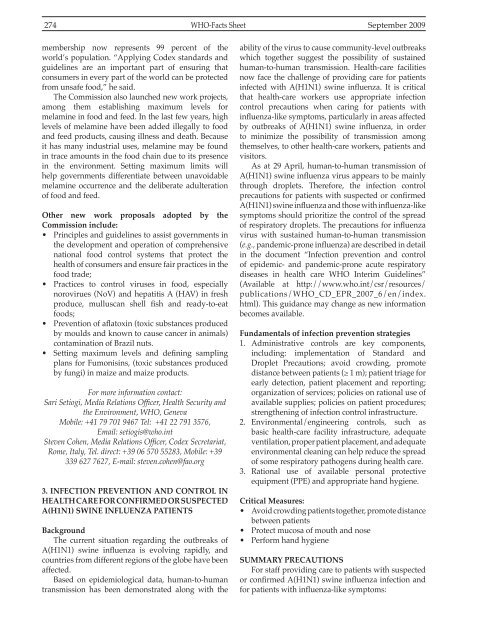Vol 41 # 3 September 2009 - Kma.org.kw
Vol 41 # 3 September 2009 - Kma.org.kw
Vol 41 # 3 September 2009 - Kma.org.kw
You also want an ePaper? Increase the reach of your titles
YUMPU automatically turns print PDFs into web optimized ePapers that Google loves.
274<br />
WHO-Facts Sheet <strong>September</strong> <strong>2009</strong><br />
membership now represents 99 percent of the<br />
world’s population. “Applying Codex standards and<br />
guidelines are an important part of ensuring that<br />
consumers in every part of the world can be protected<br />
from unsafe food,” he said.<br />
The Commission also launched new work projects,<br />
among them establishing maximum levels for<br />
melamine in food and feed. In the last few years, high<br />
levels of melamine have been added illegally to food<br />
and feed products, causing illness and death. Because<br />
it has many industrial uses, melamine may be found<br />
in trace amounts in the food chain due to its presence<br />
in the environment. Setting maximum limits will<br />
help governments differentiate between unavoidable<br />
melamine occurrence and the deliberate adulteration<br />
of food and feed.<br />
Other new work proposals adopted by the<br />
Commission include:<br />
• Principles and guidelines to assist governments in<br />
the development and operation of comprehensive<br />
national food control systems that protect the<br />
health of consumers and ensure fair practices in the<br />
food trade;<br />
• Practices to control viruses in food, especially<br />
norovirues (NoV) and hepatitis A (HAV) in fresh<br />
produce, mulluscan shell fish and ready-to-eat<br />
foods;<br />
• Prevention of aflatoxin (toxic substances produced<br />
by moulds and known to cause cancer in animals)<br />
contamination of Brazil nuts.<br />
• Setting maximum levels and defining sampling<br />
plans for Fumonisins, (toxic substances produced<br />
by fungi) in maize and maize products.<br />
For more information contact:<br />
Sari Setiogi, Media Relations Officer, Health Security and<br />
the Environment, WHO, Geneva<br />
Mobile: +<strong>41</strong> 79 701 9467 Tel: +<strong>41</strong> 22 791 3576,<br />
Email: setiogis@who.int<br />
Steven Cohen, Media Relations Officer, Codex Secretariat,<br />
Rome, Italy, Tel. direct: +39 06 570 55283, Mobile: +39<br />
339 627 7627, E-mail: steven.cohen@fao.<strong>org</strong><br />
3. INFECTION PREVENTION AND CONTROL IN<br />
HEALTH CARE FOR CONFIRMED OR SUSPECTED<br />
A(H1N1) SWINE INFLUENZA PATIENTS<br />
Background<br />
The current situation regarding the outbreaks of<br />
A(H1N1) swine influenza is evolving rapidly, and<br />
countries from different regions of the globe have been<br />
affected.<br />
Based on epidemiological data, human-to-human<br />
transmission has been demonstrated along with the<br />
ability of the virus to cause community-level outbreaks<br />
which together suggest the possibility of sustained<br />
human-to-human transmission. Health-care facilities<br />
now face the challenge of providing care for patients<br />
infected with A(H1N1) swine influenza. It is critical<br />
that health-care workers use appropriate infection<br />
control precautions when caring for patients with<br />
influenza-like symptoms, particularly in areas affected<br />
by outbreaks of A(H1N1) swine influenza, in order<br />
to minimize the possibility of transmission among<br />
themselves, to other health-care workers, patients and<br />
visitors.<br />
As at 29 April, human-to-human transmission of<br />
A(H1N1) swine influenza virus appears to be mainly<br />
through droplets. Therefore, the infection control<br />
precautions for patients with suspected or confirmed<br />
A(H1N1) swine influenza and those with influenza-like<br />
symptoms should prioritize the control of the spread<br />
of respiratory droplets. The precautions for influenza<br />
virus with sustained human-to-human transmission<br />
(e.g., pandemic-prone influenza) are described in detail<br />
in the document “Infection prevention and control<br />
of epidemic- and pandemic-prone acute respiratory<br />
diseases in health care WHO Interim Guidelines”<br />
(Available at http://www.who.int/csr/resources/<br />
publications/WHO_CD_EPR_2007_6/en/index.<br />
html). This guidance may change as new information<br />
becomes available.<br />
Fundamentals of infection prevention strategies<br />
1. Administrative controls are key components,<br />
including: implementation of Standard and<br />
Droplet Precautions; avoid crowding, promote<br />
distance between patients (≥ 1 m); patient triage for<br />
early detection, patient placement and reporting;<br />
<strong>org</strong>anization of services; policies on rational use of<br />
available supplies; policies on patient procedures;<br />
strengthening of infection control infrastructure.<br />
2. Environmental/engineering controls, such as<br />
basic health-care facility infrastructure, adequate<br />
ventilation, proper patient placement, and adequate<br />
environmental cleaning can help reduce the spread<br />
of some respiratory pathogens during health care.<br />
3. Rational use of available personal protective<br />
equipment (PPE) and appropriate hand hygiene.<br />
Critical Measures:<br />
• Avoid crowding patients together, promote distance<br />
between patients<br />
• Protect mucosa of mouth and nose<br />
• Perform hand hygiene<br />
SUMMARY PRECAUTIONS<br />
For staff providing care to patients with suspected<br />
or confirmed A(H1N1) swine influenza infection and<br />
for patients with influenza-like symptoms:
















